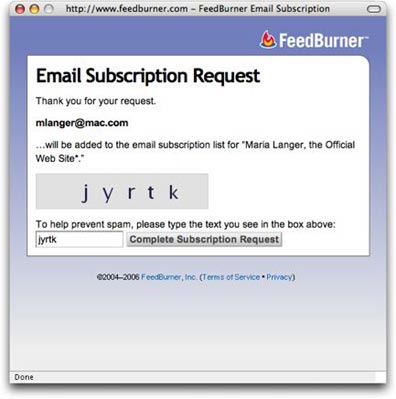Four more pingbacks from feedscrapers today!
After writing my two splogging-related posts this morning, I went for a flight with some clients. Just got back a while ago. And what do I find in my e-mail inbox? Four more splog pingbacks!
I also found a message from Jim Mitchell, responding to an e-mail I’d sent him earlier in the day. He included a link to a blog post on MaxPower that provides two good methods for stopping AdSense sploggers. I’m going through it now. But the thing I wanted to share was this explanation of what splogging is, for those of you who have no idea what I’ve been whining about all day.
From Stopping Adsense Splogs & Spammers: Methods that Work on MaxPower:
Imagine searching for something or other on the Internet and arriving at a webpage chocked full of ads and stuffed with the exact keyword you were searching for. The page is of no help because it contains no content of value. Some guy somewhere, created a website that sucks keywords / newstories / content from other websites using RSS, inserted the right keywords to maximize profit from Adsense, and waited for Google to index and rank it high enough for you stumble upon it. Once at the page, the spammer (or spamdexer) hopes that you will click on one of the Adsense ads that seem helpful compared to the rest of the useless random text. This practice of spamdexing wastes your time, its annoying, and you can fight back.
If you’ve seen this on your blog, follow the above link to the MaxPower article to see what you can do about it.

 The service, which is full automated, works with the E-Mail Notification form that appears on the site’s Home page. A person who wants to subscribe enters his e-mail address and clicks Subscribe. A window opens with a form that prompts him to enter characters in a box. When he clicks Complete Subscription Request, Feedburner generates a confirmation e-mail message and sends it to his e-mail address. That prevents people from subscribing others to this service when they might not want it. He must click the link in that message when he receives it (normally within about a minute) to start the subscription. If he doesn’t click the link, the subscription does not start.
The service, which is full automated, works with the E-Mail Notification form that appears on the site’s Home page. A person who wants to subscribe enters his e-mail address and clicks Subscribe. A window opens with a form that prompts him to enter characters in a box. When he clicks Complete Subscription Request, Feedburner generates a confirmation e-mail message and sends it to his e-mail address. That prevents people from subscribing others to this service when they might not want it. He must click the link in that message when he receives it (normally within about a minute) to start the subscription. If he doesn’t click the link, the subscription does not start.